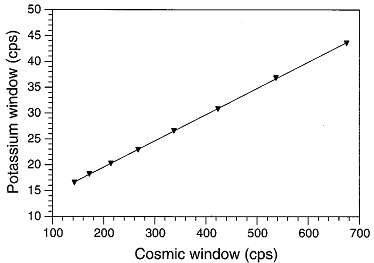9. Cosmic and carrier backgrounds
Cosmic and carrier backgrounds are used inside the FSA-based airborne correction module of Gamman. This module can be opened via [Spectral Analysis | Full-spectrum elevation correction...].
However, before opening the cosmic and carrier background creation wizard, you should have loaded a project file that contains gamma spectra acquired for cosmic and carrier background creation. For the wizard to be able to determine a cosmic and a carrier background spectrum, it needs several (tens to hundreds) of spectra flown at multiple, high altitudes.
The algorithm applied to determine cosmic and carrier background is inspired by a paper by Brian Minty (Minty, 1997). The algorithm uses the fact that in the lower atmosphere, the spectrum originating from cosmic radiation is constant in shape, and increases exponentially with increasing elevation, All radiation having energies > 3MeV stems from cosmic radiation. Most airborne gammaray systems sum up this high-energy radiation into a singe channel, the so-called cosmic channel. And some systems store the summed cosmic radiation above 3MeV in the last spectrum channel. One way or the other, the cosmic background spectrum scales linearly with this cosmic channel - within statistical margins of course.
Next to the cosmic background a detection system will see another background coming from radiation generated by the carrier (the plane or helicopter) itself. This carrier background will be a constant for a given installation, although one should note that variation in the filling of gastanks and number of operators on board will lead to a variation in carrier background.
The total background seen by a detector at high enough elevation therefore is the sum of the cosmic component scaled by the count rate in the cosmic channel and the carrier component: BG = BG_carrier + BG_cosmic * TC_cosmic; Now, by plotting for each channel the relation N_channel versus N_cosmics, one obtains a straight line (see for example the figure below, taken from Minty et al, 1997):

The straight line fit through the datapoints for each channel will give the carrier background (zero intercept) and the cosmic sensivity (cosmic count rate at elevation zero) as the slope of the regression line. The algorithm in Gamman will determine these numbers for each energy channel in the spectra passed over to the cosmic baclground wizard, and this way deconvolute the measured spectra into cosmic and carrier background components. the two resulting spectra are stored inside the project file, and can be exported using the background editor as described before.
Literature
Minty et al, GSO journal of Australian Geology and Geophysics, 17(2) 1997
